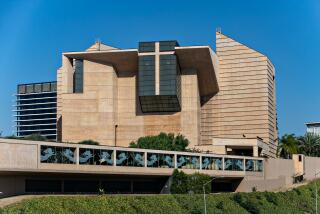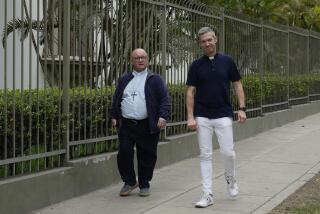No Easy Solution to Priest Problem
The sexual-abuse scandal rocking the Roman Catholic Church in the U.S. has prompted calls for reforms that often blame the crisis on a single issue: Celibacy. Or homosexuality. Or secrecy. Or imperious bishops.
But what has made this scandal more intense and prolonged than its predecessors is the complex way each of these issues interlock.
The complexity explains why the scandal has outraged and energized such a wide range of church constituencies: Liberal Catholics believe the church can be healed by permitting married priests and the ordination of women. Ardent traditionalists who link homosexuality to sexual abuse see the scandal as a sign that the church must return to a holiness grounded in fealty to traditional teachings. Still others call for a democratization of the church so that bishops, who answer only to Pope John Paul II, will be held accountable by their dioceses.
“We’ve had so much institutional culture shock that the deeper [question] is where to go from here,” said Dennis Doyle, a church historian and professor at the University of Dayton in Ohio, founded by the Marianist teacher order.
The current scandal has struck with unprecedented breadth and fury. In the last three months scores of priests from coast to coast and three bishops around the world have resigned, been fired or asked to retire.
So volatile is the debate that rational discussion is impaired. “We are in a dangerous period. . . . Everyone inside and outside the church, wants to find simplistic solutions,” wrote Father Stephen J. Rossetti, president of the St. Luke Institute, which treats sexually abusing priests, in the upcoming issue of the Jesuit magazine America.
The church’s dilemma lies at the intersection of celibacy, homosexual and secrecy.
Celibacy
What one often hears is that if an offending priest had a healthy sexual outlet--in other words, a wife--he wouldn’t turn to minors for sexual gratification.
But to suggest a direct correlation between celibacy and the sexual abuse of minors is both facile and specious. Study after study demonstrate that pedophilia, an attraction to pre-pubescent children, and ephebophilia, an attraction to post-pubescent youths, more often involves heterosexual men who are friends or relatives of their victims.
In such cases, the abusers suffer from what psychologists call arrested psychosexual development. They are sexually immature. Often they have difficulty relating to and negotiating with adults. In other cases, they may have experienced feelings of abandonment and low self-esteem.
In other cases, heterosexual men have been known to molest boys, not necessarily because of latent homosexual feelings, but because they were molested when they were young. These are but a few explanations of a complex pathology.
Nonetheless, celibacy can introduce added tensions in the life of a priest who is not psychologically healthy or emotionally mature.
In years past, many priests who later became offenders had moved directly from high school seminaries to graduate seminaries without the usual life experiences common to most other young men.
Once in seminary, their sexual maturity was further impeded as the church inculcated its future priests with the value and necessity of celibacy. Celibacy is seen as a way of “donating” oneself completely to God and to those to whom the priest ministers as an “icon of Christ.”
Seminarians have been known to surreptitiously explore their sexuality, but several priests said in interviews with The Times that they didn’t want to risk their future ordination by getting caught. They waited until after they were ordained. (None of these priests are known to have ever been accused of sexual abuse of minors.)
Celibacy is difficult under the best of circumstances. Richard Sipe, a former priest who has closely studied the issue, reports that at any given time only 50% of priests are celibate. Over a priest’s lifetime, only 2% are consistently celibate, Sipe says.
Though his figures are disputed by many in the church, few argue that celibacy requires at least two essential factors to work: an authentic spirituality, and nonsexual intimacy with good and trusted friends who may or may not be in the priesthood.
One who has underscored this is Father Donald B. Cozzens, the president-rector of Saint Mary Seminary and Graduate School of Theology in Cleveland.
“Paradoxically,” Cozzens told The Times, “the safest path to an authentic life of celibacy is not to eschew friendship because it’s a threat, but to enter into honest relationships that are intimate without being sexual.”
Yet for a priest who is not emotionally mature or psychologically healthy, relating to adults and sharing intimate details of his life may be a daunting challenge. He may inappropriately turn to youths to fill his needs for love and intimacy.
In years past, most seminaries did not address issues of human sexuality. That is changing. Most of the priests caught up in the latest scandal are older men, many of them retired. That may be a hopeful sign that more comprehensive psychological screening of seminary applicants and a fuller discussion of sexual issues may be paying off.
But there is no foolproof psychological test to ferret out pedophiles or ephebophiles.
Homosexuality
Many of the recent cases of priestly abuse that have stunned the nation involve post-pubescent boys. Some church critics argued that if homosexual priests were purged, the problem would decline.
This suggestion feeds on an old and disproved stereotype that gay men are more likely to molest youths than heterosexual men. Here, again, experts and leading bishops say retarded psychosexual development, not sexual orientation, is the problem.
Few deny the enormous contributions that priests who are gay continue to make to the life and ministry of the church. It is often said that were they suddenly to leave the scene, the church would be thrown into a crisis. Its current priesthood shortage would be compounded many times over.
Nevertheless, the presence of what is widely viewed as disproportionate numbers of homosexuals in the priesthood has, in some critics’ minds, changed the culture of the church. If present ordination trends continue, Sipe predicts, a majority of priests will be homosexuals by 2010.
Theology school president Cozzens said that, based on 36 years in the priesthood, estimates that at least 20% of priests have homosexual orientations are probably understated, although he could not say what the higher figure should be.
Whatever the percentage, bishops in the past have quashed suggestions that the church undertake polls to find out just how many of its priests are homosexual. It is an issue they simply do not want to deal with.
The church does ordain homosexuals. It was long thought that a man’s sexual orientation was irrelevant since all priests, straight or gay, are required to live a celibate life.
But gay priests face dilemmas unknown to heterosexual clergy. The church teaches that a homosexual orientation is “objectively disordered” and that homosexual acts are “intrinsically evil.” More recently, the pope’s Vatican press secretary, Joaquin Navarro-Valls, said the church should not ordain homosexuals and even suggested that the ordination of current homosexual priests may be invalid.
Gay priests learned long ago to remain in the closet. Most feel they could not possibly “come out” to their parishioners and expect to keep their jobs. The tension created by their decision is only part of a culture of secrecy that has bedeviled the church.
Secrecy
Secrecy, not sexual orientation, is responsible for the depth of the current crisis. Catholics outraged by the sexual abuse at least understood how a priest could fall. But they could not countenance the secrecy of some of their bishops, who knowingly shuffled sexual-abuser priests from parish to parish and left parishioners in the dark.
Though the bishops no doubt believed they were protecting the church from scandal, in retrospect most now realize they did greater damage by not firing wayward priests and being more open with their parishioners. Their most frequent defense has been that psychologists advised them that priests who molested adolescents could be successfully treated.
Resentment of secrecy in the church has given more spirit to long-running contentions among reformers who have called for a bigger voice for the laity in the American church and demanded more accountability from bishops. Other denominations allow churches to hire and fire their clergymen and elect their bishops, but the Catholic hierarchy has zealously guarded those prerogatives.
The secrecy argument leads not only to discussion of accountability but also to the question of whom the church allows to be priests. Liberals argued that women and married men would not have stood for the secrecy of sexual abuse. Nor, they say, would the church’s progress in addressing the problem have been so uneven.
“If there were women priests and women bishops and married bishops, the likelihood of this happening in the first place would be close to nil,” said Terrance Sweeney of Encino, who left the priesthood to be married. “Men and women who were in positions of authority in the church, who had young children, simply would not have tolerated this. They would not have tolerated the secrecy.”
Bishops dispute that. In the last decade, most have put sexual-abuse prevention policies into place, and they have toughened them over the years.
Yet leaders of abuse-victims groups believe it took outside pressures--among them tougher criminal laws requiring the reporting of sexual abuse and costly settlements with victims--to force the church to act.
*
RELATED STORY
Cleric removed: Mission Viejo Jesuit ousted pending probe. B6
More to Read
Sign up for Essential California
The most important California stories and recommendations in your inbox every morning.
You may occasionally receive promotional content from the Los Angeles Times.










